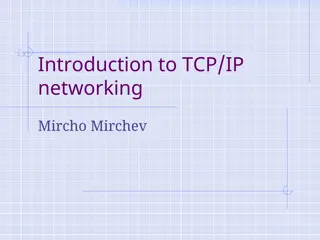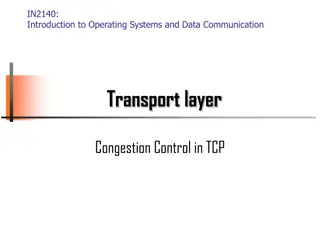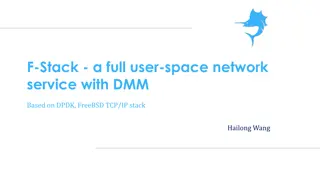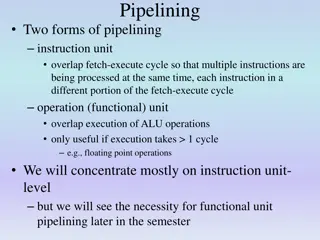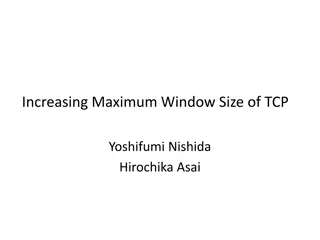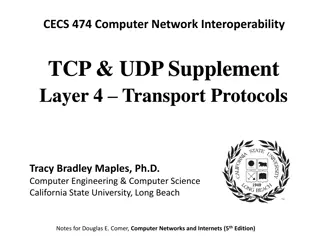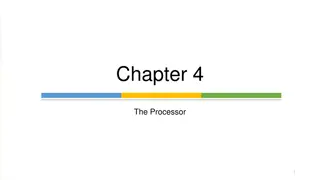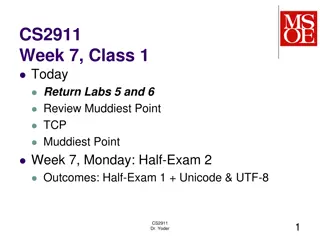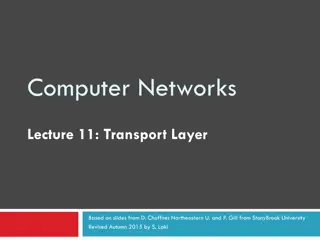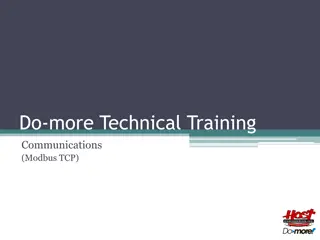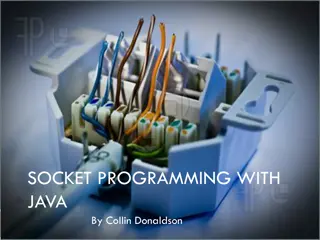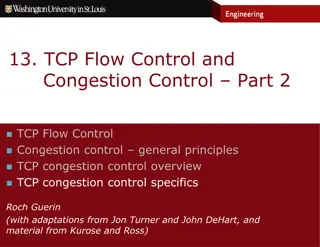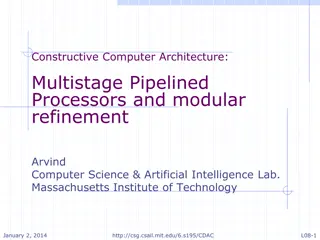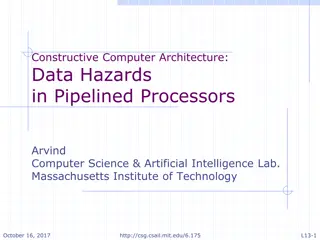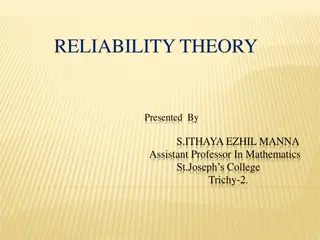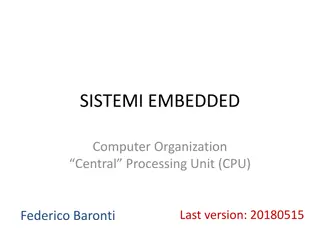Understanding TCP Reliability and Pipelined Delivery
This lecture delves into the concepts of TCP reliability and pipelined data delivery, emphasizing the need for mechanisms to ensure data integrity and accuracy. It covers error detection, handling delayed and dropped packets, setting retransmission timeouts (RTO), coping with packet duplication and loss using sequence numbers, and more. The content provides insights on improving the reliability of data transmission over networks.
Download Presentation

Please find below an Image/Link to download the presentation.
The content on the website is provided AS IS for your information and personal use only. It may not be sold, licensed, or shared on other websites without obtaining consent from the author. Download presentation by click this link. If you encounter any issues during the download, it is possible that the publisher has removed the file from their server.
E N D
Presentation Transcript
CS 352 Reliability: Pipelined Delivery Lecture 12 http://www.cs.rutgers.edu/~sn624/352-F22 Srinivas Narayana 1
Quick recap of concepts TCP Connection-oriented UDP Connectionless Detecting errors is insufficient. Need to correct errors. Error detection Also, data may simply be lost. (checksum is also lost) Sender Receiver Need better mechanisms for reliable data delivery! f(.) f(.) Checksum Checksum TCP uses 3 simple ideas Compare* Note: actual impl more nuanced
Review: Sender sends a single packet, then waits for an ACK to know the packet was successfully received. Then the sender transmits the next packet. Receiver Sender RTT ACK delayed ACK dropped Pkt dropped Pkt corrupted If ACK is not received until a timeout (RTO), sender retransmits the packet How to set the RTO? Bad RTO: retransmit too early or too late RTO Retransmit
How should the RTO be set? Receiver Sender A good RTO must predict the round-trip time (RTT) between the sender and receiver RTT: the time to send a single packet and receive a (corresponding) single ACK at the sender RTO Intuition: If an ACK hasn t returned, and our (best estimate of) RTT has elapsed, the packet was likely dropped. ACK RTT can be measured directly at the sender. No receiver or router help needed.
Coping with packet duplication Receiver Sender If ACKs delayed beyond the RTO, sender may retransmit the same data Receiver wouldn t know that it just received duplicate data from this retransmitted packet RTO Duplicate packet received! (Receiver doesn t know ) Add some identification to each packet to help distinguish between adjacent transmissions This is known as the sequence number ACK
Coping with packet loss: (3) Sequence #s Receiver Sender A bad scenario: Suppose an ACK was delayed beyond the RTO; sender ended up retransmitting the packet. 0 RTO At the receiver: sequence number helps disambiguate a fresh transmission from a retransmission Sequence number same as earlier: retransmission Fresh sequence number: fresh data 0 ACK
Coping with packet loss: (3) Sequence #s Receiver Sender A good scenario: packet successfully received and ACK returned within RTO SEQ 0 Receiver knows these are not duplicate, because sequence numbers are different RTO ACK Sequence numbers of successively transmitted packets are different SEQ 1 RTO
Coping with packet loss: (3) Sequence #s Receiver Sender A good scenario: packet successfully received and ACK returned within RTO SEQ 0 Receiver knows these are not duplicate, because sequence numbers are different RTO ACK ACK Sequence numbers of successively transmitted packets are different SEQ 1 RTO ACK
Q: What is the seq# of third packet? Receiver Sender Goal: Avoid ambiguity on which packet was received/ACK ed from both the sender and receiver s perspective One option: increment seq#: 2, 3, Alternative: since seq # 0 was successfully ACK ed earlier, it is OK to reuse seq #0 for next transmission. Seq #s reusable if older packets with those seq #s known to be delivered SEQ 0 RTO ACK SEQ 1 RTO ACK ???
Stop-and-Wait Reliability Sender sends a single packet, then waits for an ACK to know the packet was successfully received. Then the sender transmits the next packet. Receiver Sender SEQ 0 RTT ACK If ACK is not received until a timeout (RTO), sender retransmits the packet SEQ 1 Disambiguate duplicate vs. fresh packets using sequence numbers that change on adjacent packets RTO Retransmit
In principle, these three ideas are sufficient to implement reliable data delivery!
Making reliable data transfer efficient
Efficiency problem with stop-and-wait Receiver Sender Sender sends one packet, waits for an ACK (or RTO) before transmitting next one Unfortunately, too slow RTT Suppose RTO = RTT = 100 milliseconds Packet size (bytes in 1 packet) = 12,000 bits Bandwidth of links from sender to receiver = 12 Mbit/s (1 M = 106) RTO Rate of data transfer = data size / time 120 Kilobit/s == 1% of bw!
Sending one packet per RTT makes the data transfer rate limited by the time between the endpoints, rather than the bandwidth. Ensure you got the (one) box safely; make N trips Ensure you get N boxes safely; make just 1 trip! Keep many packets in flight
Pipelined reliability Data in flight: data that has been sent, but sender hasn t yet received ACKs from the receiver Note: can refer to packets in flight or bytes in flight New packets sent at the same time as older ones still in flight New packets sent at the same time as ACKs are returning More data moving in same time! Improves throughput Rate of data transfer
Pipelined reliability Receiver Sender Stop and wait: send 1 packet per RTT Pipelined: send N packets per RTT RTT If there are N packets in flight, throughput improves by N times compared to stop-and- wait! RTO
Pipelining makes reliable data transfer efficient. However, pipelining also makes it more complex. Which packets are currently in flight? Which packets were successfully delivered? Which packets should the sender retransmit?
Setup Receiver Sender Assume packets are labeled by sequence numbers Increasing from 0, , N-1, then roll back to 0 Assume ACKs indicate the sequence numbers of data that was received Note: Didn t need this for stop-and-wait Convention: ACK#s carry the next sequence number expected Used in TCP.
Sliding window (sender side) Window: Sequence numbers of in-flight data Window size: The amount of in-flight data (unACKed) Sequence numbers restart from 0 beyond a point (finite space on header) Window size = 3 Sender s point of view: 0 1 0 3 1 4 2 5 7 6 0 7 1 6 2 Last seq # known to be received (ACK recv d at sender) Last sequence # sent 3 5 4 Transmissions later in time
Sliding window (sender side) Suppose sequence number 2 is acknowledged by the receiver Sender receives the ACK. Sender can transmit sequence # 5 The window slides forward Window size = 3 Sender s point of view: 0 1 0 3 1 4 2 5 7 6 0 7 1 6 2 Last seq # known to be received (ACK recv d at sender) Last sequence # sent 3 5 4
Sliding window (sender side) Suppose sequence number 2 is acknowledged by the receiver Sender receives the ACK. Sender can transmit sequence # 5 The window slides forward Window size = 3 Sender s point of view: 0 1 0 3 1 4 2 5 7 6 0 7 1 6 2 Last seq # known to be received (ACK recv d at sender) Last sequence # sent 3 5 4
Sliding window (receiver side) Window of in-flight packets can look different between sender and the receiver Receiver only accepts sequence #s allowed by the current receiver window Window size = 3 Receiver will not accept this seq #. Packet dropped Receiver s point of view: 1 0 3 1 4 2 5 7 6 0 Last seq # received and ACK ed by receiver Highest sequence # accepted
Summary of sliding windows Sender and receiver can keep several packets of in-flight data Book-keep the sequence numbers using the window Windows slide forward as packets are ACKed (at receiver) and ACKs are received (at sender) Common case: Improve throughput by sending and ACKing more packets in the same duration
Pipelining makes reliable data transfer efficient. However, pipelining also makes it more complex. Which packets are currently in flight? Which packets were successfully delivered? Which packets should the sender retransmit?
How to identify dropped packets? Suppose 4 packets sent, but 1 dropped. How does sender know which one(s) dropped? Receiver Sender Recall: Receiver writes sequence numbers on the ACK indicating successful reception Key idea: Sender can infer which data was received successfully using the ACK #s! Hence, sender can know which data to retransmit RTT Should this ACK exist ??? Q1: Should receivers ACK subsequent packets upon detecting data loss? Q2: If so, what sequence number should receiver put on the ACK? RTO
Receiver strategies upon packet loss Receiver Sender ACK pkts after a drop? 1 2 No Yes 3 4 Go-back-N Selective Repeat What # on ACK? 5 Seq# ranges received so far Selective ACK TCP s default Last seq# in order Cumulative ACK
Sliding Window with Go Back N When the receiver notices missing data: It simply discards all data with greater sequence numbers i.e.: the receiver will send no further ACKs The sender will eventually time out (RTO) and retransmit all the data in its sending window Subtle: conceptually, separate timer per byte to infer RTO
Go back N RTO Sender Maximum window size = 8 0 1 2 3 4 2 3 4 5 6 Receiver Maximum window size = 8 0 1 2 3 4 5 6 E D D Discarded by receiver Dropped packet (or) Packet with error Time
Go back N Go Back N can recover from erroneous or missing packets. But it is wasteful. If there are errors, the sender will spend time and network bandwidth retransmitting data the receiver has already seen.
Selective repeat with cumulative ACK Idea: sender should only retransmit dropped/corrupted data. The receiver stores all the correct frames that arrive following the bad one. (Note that the receiver requires memory to hold data for each sequence number in the receiver window.) When the receiver notices a skipped sequence number, it keeps acknowledging the first in-order sequence number it wants to receive. This is termed cumulative ACK. When the sender times out waiting for an acknowledgement, it just retransmits the first unacknowledged data, not all its successors. Recall that RTO applies independently to each sequence #
Selective repeat with cumulative ACK RTO Sender Maximum window size = 8 0 1 2 3 4 2 5 6 Receiver Maximum window size = 8 0 1 3 4 2 5 6 E Buffered by receiver in its memory Packet with error (or) dropped packet Time
Selective repeat with selective ACK RTO Sender Maximum window size = 8 0 1 2 3 4 2 5 6 Receiver Maximum window size = 8 0 1 3 4 2 5 6 E Buffered by receiver in its memory Frame with error Time
TCP: Cumulative & Selective ACKs Receiver Sender Sender retransmits the seq #s it thinks aren t received successfully yet Pros & cons: selective vs. cumulative ACKs Precision of info available to sender Redundancy of retransmissions Packet header space Complexity (and bugs) in transport software On modern Linux, TCP uses selective ACKs by default 1 2 3 4 2 3 4 5 5






